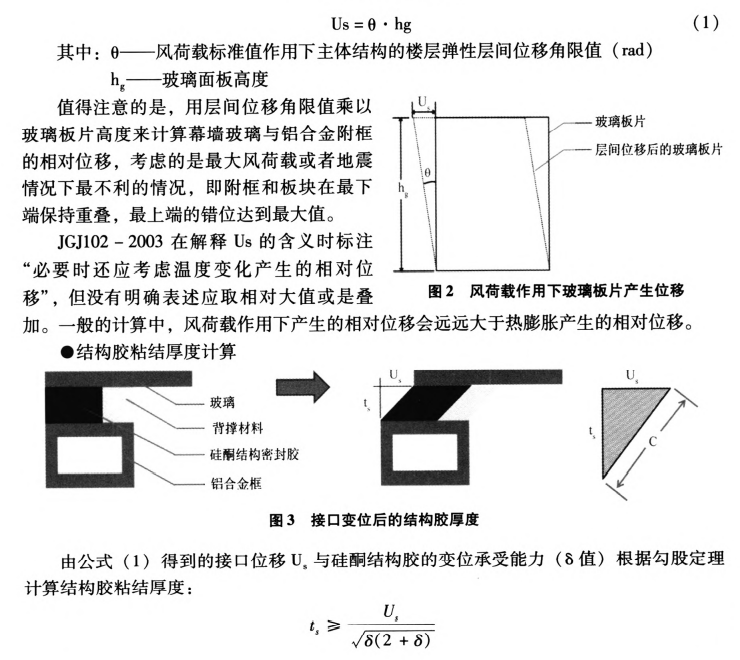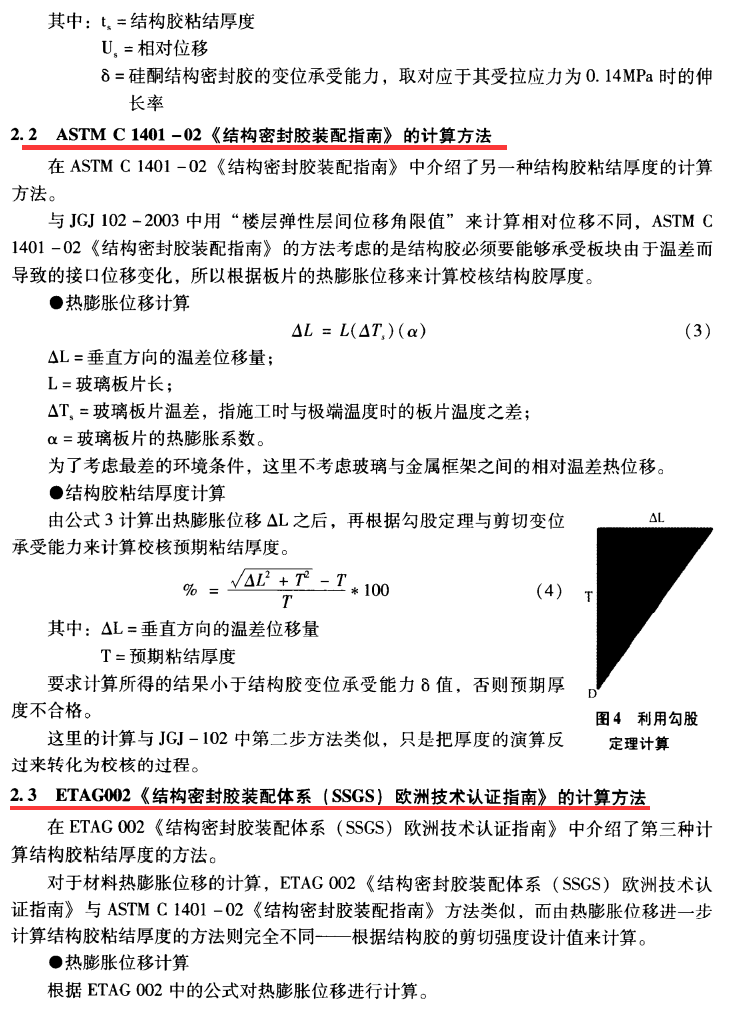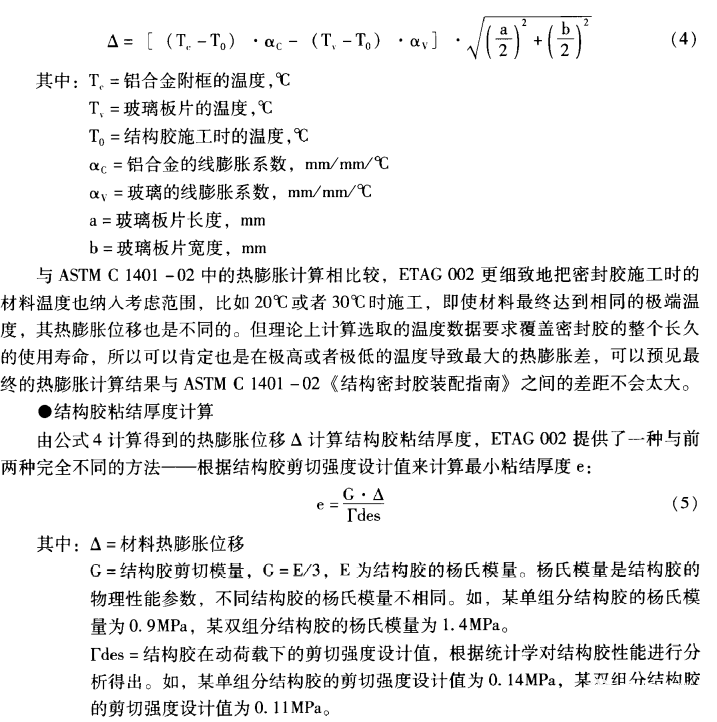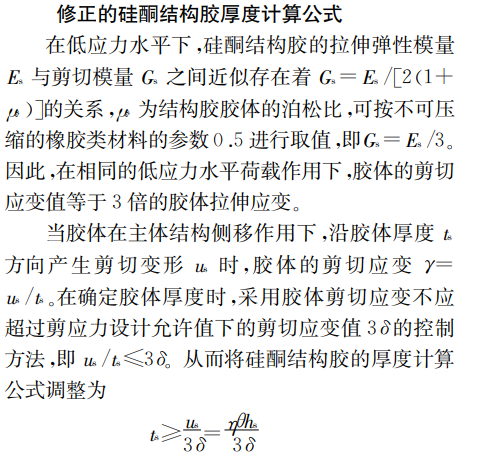
Calculation and specification of structural adhesive
A key link in the design of hidden frame glass curtain wall is to calculate and determine the width and thickness of silicone structural adhesive. The width and length of colloid are mainly used to resist out of plane wind load, seismic action and gravity load transmitted by glass panel. The thickness of silicone structural adhesive is mainly used to digest the adverse effect of interlayer deformation of main structure on hidden frame glass curtain wall.
Several specifications related to the thickness calculation of structural adhesive at home and abroad include:
JGJ 102-2003 technical code for glass curtain wall engineering
ASTM C 1401-02 structural sealant assembly guide
Etag002 European technical certification guide for structural sealant assembly system (SSGs)
III. in this specification, it is a consensus that the structural bit is calculated from the plate size and the design value of structural adhesive strength according to the trapezoidal load rule, while the three specifications are different for the calculation of glueline thickness. The calculation methods of the three specifications are based on the relative displacement of glass plate and aluminum alloy frame to calculate the bonding thickness of structural adhesive, but the calculation methods of relative displacement are completely different, so the calculation results are also different. Here are the examples listed in the articles previously published by Chengdu Sibao Kang Zijian and Zhou Wenliang:




How to understand the specifications?
1. What is the effect of too thick and too thin structural adhesive on stress?
For most adhesive materials, the size and volume of structural adhesive of building curtain wall are in direct proportion to the probability of defects such as pores and cracks in the structural adhesive, that is, the larger the size and volume of structural adhesive of building curtain wall, the more defects such as pores and cracks. However, the smaller the thickness of structural adhesive is, the better. When the thickness of structural adhesive is less than a certain value, the tensile shear strength decreases due to its too small thickness, which is prone to the problems of weak adhesive layer interface and stress accumulation due to lack of adhesive.
2. Common problems of structural adhesive thickness calculation in JGJ 102-2003 technical code for glass curtain wall engineering
It can be seen that if the structural adhesive is calculated and constructed according to the method in JGJ 102-2003 technical code for glass curtain wall engineering, the calculated structural adhesive thickness is generally too large due to the large floor elastic interlayer displacement and deformation of the main structure of the building under wind load. In order to solve this contradiction, some curtain wall design software defaults the displacement bearing capacity of silicone structural adhesive to 12 ~ 14%. Compared with the existing silicone structural adhesive products at home and abroad, even if this is a large value, when encountering some large plates, the final calculation result may still exceed the maximum allowable thickness of 12mm, which is an unresolved contradiction so far.
3. Discussion on JGJ 102-2003.
Liu junjin and others of the Academy of construction Sciences analyzed the formula and found that there were some irrationalities in the formula:
1) When the lateral movement between the layers of the main structure occurs, there will be relative deformation between the glass panel and the supporting frame of the hidden frame glass curtain wall. Since there is no tensile stress along the thickness direction of the colloid, the deformation should be understood as shear deformation. Therefore, the control method of limiting the shear strain value in the thickness direction of the colloid should be changed to be reasonable than limiting the oblique tensile in the thickness direction of the colloid;
2) The assumption that "the colloid shear deformation is equal to the interlayer displacement of the main structure within the height range of the glass panel" in the calculation is unreasonable. Because when the main structure moves between layers, the relative deformation between the main structure and the glass panel is shared and absorbed by three aspects:
① The curtain wall beam column and the main structure absorb deformation through the rotation of bolt connection;
② There is a certain relative deformation between the sub frame of hidden frame glass curtain wall and the beam column of curtain wall;
③ Some deformation is absorbed between the glass panel and the sub frame through silicone structural adhesive.
As the above deformation cannot be accurately calculated, it is reserved as safety margin and will not be considered temporarily. For the third aspect, when the interlayer shear deformation of the main structure occurs under the action of wind or earthquake, once the main structure and the curtain wall panel have relative deformation, the shear stress in the silicone structural adhesive will drive the glass panel to rotate in the same direction, which makes the shear deformation borne by the structural adhesive less than the lateral displacement of the main structure. Therefore, the shear deformation value of silicone structural adhesive in the formula should be reduced on the basis of the interlayer displacement of the main structure.

According to the test results and finite element analysis, the shear deformation borne by the two structural adhesives is only about 20% of the lateral displacement of the main structure. In other words, the deformation of structural glue under external force is about 20% of the deformation displacement of building curtain wall structure.
Through experiments and theoretical calculations, there are several other conclusions:
1. The shear displacement reduction coefficient of silicone structural adhesive is only related to the height width ratio of glass panel and the interlayer displacement angle of main structure, which is usually between 0.05 and 0.49. However, in order to avoid excessive relaxation, if this calculation is required, the shear displacement reduction coefficient of silicone structural adhesive is recommended at this stage η Take 0.5 safely.

2. According to the data of Chinese silicone structural adhesive manufacturers, the tensile displacement performance index of silicone structural adhesive δ The value is usually between 7 and 12%. Therefore, when the calculated value of silicone structural adhesive thickness is greater than the minimum structural thickness by 6mm, the calculated value of silicone structural adhesive thickness determined by the correction formula will be reduced by 9 ~ 30% compared with the calculated value of jgj102. The modified formula is conducive to reducing the consumption of silicone structural adhesive materials. For large glass curtain wall plate, the design of hidden frame glass curtain wall is easier to be realized in practical engineering. However, the specific problems should be analyzed in detail. The above contents are only used as some discussions on the design method, and the project should also be based on the specifications.